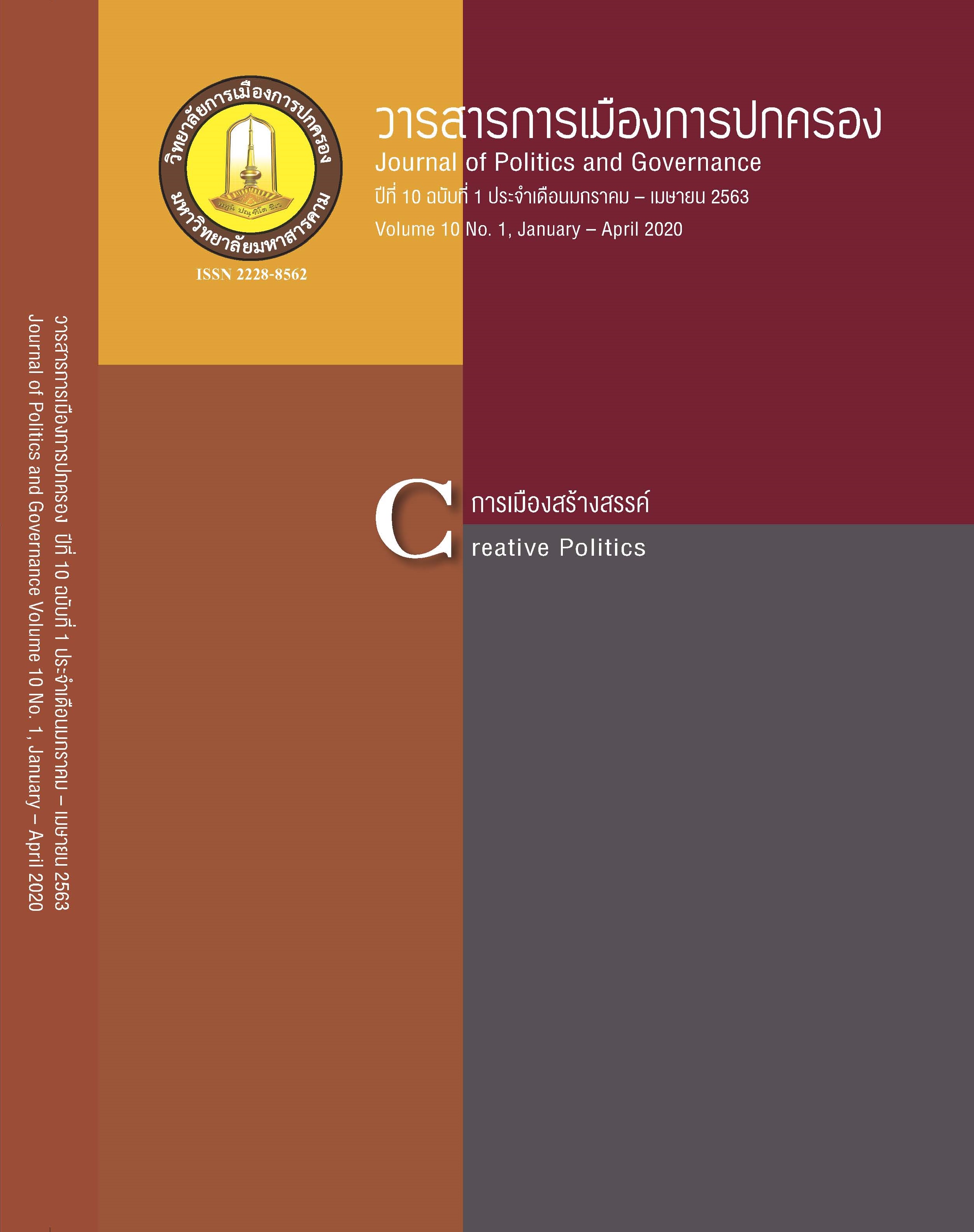Comparison of Public Participation in Environmental and Health Impact Assessment between Thailand and other countries
Main Article Content
Abstract
The objectives of this article are to review and to compare public participation guideline in environmental and health impact assessment (EHIA) projects between Thailand and other countries. The public participation guidelines for EHIA projects in Thailand United Kingdom, the Netherlands, Sweden, Norway, USA, Canada, Australia, Japan and China were reviewed. This article found that public participation of EHIA in Thailand is similar to the Netherlands, Sweden, USA, and Japan since the public participation starts at the scoping stage. However, Thailand is different from Canada and Japan in terms of stakeholder identification. In Thailand, anyone can attend public participation program while Canada and Japan only allow people who directly affected from the project to involve in public participation program. The study also found that public participation in Thailand is formal and inflexible which is different from Sweden, United Kingdom, and Australia. There is no capacity building to the stakeholders in Thailand to get involved in public participation program. By contrast, Canada has participant funding programs to support meaningful participation of direct affected people and indigenous people.
Article Details
References
คนางค์ คันธมธุรพจน์ (2561). การมีส่วนร่วมของประชาชนในการประเมินผลกระทบสิ่งแวดล้อม. กรุงเทพฯ: แดเน็กซ์อินเตอร์คอร์ปอเรชั่น.
จิรนนท์ พุทธา และจําลอง โพธิ์บุญ. (2558). การประเมินสิ่งแวดล้อมระดับยุทธศาสตร์ (SEA) ของยุทธศาสตร์การพัฒนาเขตเศรษฐกิจพิเศษ จังหวัดกาญจนบุรี. วารสารวิจัยสหวิทยาการไทย 10(2), 8-15.
ถวิลวดี บุรีกุล. (2552). พลวัตรการมีส่วนร่วมของประชาชน: จากอดีตจนถึงรัฐธรรมนูญแห่งราชอาณาจักรไทย พุทธศักราช 2550. กรุงเทพมหานคร: บริษัท เอ.พี.กราฟิค ดีไซน์และการพิมพ์ จำกัด.
ปภาดา ประมาณพล และ สุนีย์ มัลลิกะมาลย์. (2557). แนวทางการปรับปรุงแก้ไขกฎหมายเกี่ยวกับการเข้าถึงข้อมูลข่าวสารด้านสิ่งแวดล้อม. วารสารวิชาการศรีปทุม ชลบุรี, 10(4), 90-98.
ปาริชาต ศิวะรักษ์. (2558). ข้อเสนอการปฏิรูปด้านการบริหารจัดการทรัพยากรธรรมชาติและสิ่งแวดล้อม: ระบบการประเมินผลกระทบสิ่งแวดล้อมและสุขภาพ. ใน ดร.บัณฑูร เศรษฐศิโรตม์ และรัตนาภรณ์ อาณาประโยชน์ (Ed.), โครงการชุดความรู้เพื่อการบริหารจัดการทรัพยากรธรรมชาติและสิ่งแวดล้อมเพื่อการปฏิรูปประเทศ.
พรชัย สิทธิศรัณย์กุล. (2557). อริยสัจ 4 เรื่องการประเมินผลกระทบต่อสุขภาพและสิ่งแวดล้อม. ธรรมศาสตร์เวชสาร, 14(1), 102-106.
พระราชบัญญัติส่งเสริมและรักษาคุณภาพสิ่งแวดล้อมแห่งชาติ (ฉบับที่ 2) พ.ศ.2561. (2561, 19 เมษายน). ราชกิจจานุเบกษา. เล่ม 135 ตอนที่ 27 ก. หน้า 29-43.
สมฤดี นิโครวัฒนยิ่งยง. (2553). จับสถานการณ์ธรรมาภิบาลสิ่งแวดล้อม เพิ่มการวิเคราะห์รัฐธรรมนูญ (2550). นนทบุรี: สถาบันสิ่งแวดล้อมไทย.
สำนักงานนโยบายและแผนทรัพยากรธรรมชาติและสิ่งแวดล้อม. (2549). แนวทางการมีส่วนร่วมของประชาชนและการประเมินผลกระทบสิ่งแวดล้อมทางสังคมในกระบวนการวิเคราะห์ผลกระทบสิ่งแวดล้อม. สืบค้นจาก http://www.onep.go.th/eia/images/ 7handbook/book_pop_attend2.pdf
สำนักนายกรัฐมนตรี. (2548). ระเบียบสำนักนายกรัฐมนตรีว่าด้วยการรับฟังความคิดเห็นของประชาชน พ.ศ.2548 (ราชกิจจานุเบกษา). สืบค้นจาก http://www.nstda.or.th/nstda-knowledge/22-knowledge/4930-public-consultation
สุพร บัวทอง. (2557). หลักเกณฑ์และแนวทางที่เหมาะสมในกระบวนการรับฟังความคิดเห็นของประชาชน. วารสารการเมือง การบริหาร และกฎหมาย, 6(2), 217-236.
Bassi, Andrea, Howard, Robert, Geneletti, Davide, & Ferrari, Simone. (2012). UK and Italian EIA systems: A comparative study on management practice and performance in the construction industry. Environmental Impact Assessment Review, 34, 1-11.
Bond, Alan, & Stewart, Gerard. (2002). Environment agency scoping guidance on the environmental impact assessment of projects. Impact Assessment and Project Appraisal, 20(2), 135-142.
Brombal, Daniele, Moriggi, Angela, & Marcomini, Antonio. (2017). Evaluating public participation in Chinese EIA. An integrated Public Participation Index and its application to the case of the New Beijing Airport. Environmental impact assessment review, 62, 49-60.
Canadian Environmental Assessment Agency. (2016). Participant Funding Program – National Program Guidelines: Program Process. Retrieved from https://www.canada.ca/en/environmental-assessment-agency/services/policy-guidance/participant-funding-program-national-program-guidelines/participant-funding-program-national-program-guidelines-program-process.html.
De Santo, Elizabeth M. (2016). Assessing public “participation” in environmental decision-making: Lessons learned from the UK Marine Conservation Zone (MCZ) site selection process. Marine Policy, 64, 91-101.
Department of Environment and Heritage Protection. (2017). Environmental Impact Statement (EIS) Processes. Retrieved from https://www.ehp.qld.gov.au/ management/impact-assessment/
Environmental Protection Authority. (2016a). Environmental Impact Assessment (Part IV Divisions 1 and 2) Procedures Manual 2016. Retrieved from http://www.epa.wa.gov.au/sites/default/files/Policies_and_Guidance/EIA%20Procedures%20Manual-171017.pdf.
Environmental Protection Authority. (2016b). Stakeholder Engagement. Retrieved from http://www.epa.wa.gov.au/stakeholder-engagement
Environmental Protection Authority. (2018). Public comment and submissions on proposals. Retrieved 11 April 2018, from Government of Western Australia, Retrieved from http://www.epa.wa.gov.au/public-comment-and-submissions-proposals
Fluker, Shaun, & Srivastava, Nitin Kumar. (2016). Public Participation in Federal Environmental Assessment under the Canadian Environmental Assessment Act 2012: Assessing the Impact of" directly affected". Journal of Environmental Law and Practice, 29, 65.
Gibson, Robert B. (2012). In full retreat: the Canadian government's new environmental assessment law undoes decades of progress. Impact Assessment and Project Appraisal, 30(3), 179-188.
Glasson, J., & Therivel, R. (2013). Introduction to environmental impact assessment: Routledge.
Glucker, Anne N, Driessen, Peter PJ, Kolhoff, Arend, & Runhaar, Hens AC. (2013). Public participation in environmental impact assessment: why, who and how?. Environmental impact assessment review, 43, 104-111.
Mällberg, Camilla. (2015). Quality Assurance in the Review Process of the Swedish EIA System. (master degree), Stockholm University, Retrieved from http://www.diva-portal.org/smash/get/diva2:824222/FULLTEXT01.pdf
Moorman, Jesse L, & Ge, Zhang. (2006). Promoting and strengthening public participation in China's environmental impact assessment process: comparing China's EIA law and US NEPA. Vt. J. Envtl. L., 8, 281.
Nenasheva, Marina, Bickford, Sonja H, Lesser, Pamela, Koivurova, Timo, & Kankaanpaa, Paula. (2015). Legal tools of public participation in the Environmental Impact Assessment process and their application in the countries of the Barents Euro-Arctic Region. Barents Studies: Peoples, Economies and Politics, 1(3), 13-35.
Ogihara, Akira, Shimaoka, Mikiko, & Roppongi, Hitomi. (2016). Potentialities for a regional public participation framework in Asia: An environmental assessment perspective. Land Use Policy, 52, 535-542.
Shepherd, Anne, & Bowler, Christi. (1997). Beyond the requirements: improving public participation in EIA. Journal of environmental planning and management, 40(6), 725-738.
Steinhauer, Ineke. (2012). Public Participation in EIAs and SEAs: Lessons Learnt in the Netherlands and their Application Abroad. Retrieved from http://api.commissiemer.nl/docs/mer/diversen/views_experiences_2012_p46-55.pdf.
Suwanteep, Kultip, Murayama, Takehiko, & Nishikizawa, Shigeo. (2016). Environmental impact assessment system in Thailand and its comparison with those in China and Japan. Environmental impact assessment review, 58, 12-24.
UN Environment. (2018). Assessing Environmental Impacts - A Global Review of Legislation. Nairobi, Kenya.
UNCED. (1992). The Rio Declaration on Environment and Development. Retrieved from http://www.unesco.org/education/pdf/RIO_E.PDF
UNECE. (1998). Convention on Access to Information, Public Participation in Decision-Making and Access to Justice in Environmental Matters. Retrieved from https://www.unece.org/fileadmin/DAM/env/pp/documents/cep43e.pdf
UNECE. (2015). Environmental Assessment: Convention on Environmental Impact Assessment in a Transboundary Context. Retrieved from http://www.unece.org/env/eia/welcome.html
Wangwongwatana S., Sano D., and Noel King P. (2015). Assessing Environmental Impact Assessment (EIA) in Thailand: Implementation Challenges and Opportunities for Sustainable Development Planning. Paper presented at the Asian Environmental Compliance and Enforcement Network (AECEN) Working Paper, Hayama, Japan. Retrieved from http://www.aecen.org/sites/default/ files/eia_thai_study_10mar15-final.pdf


